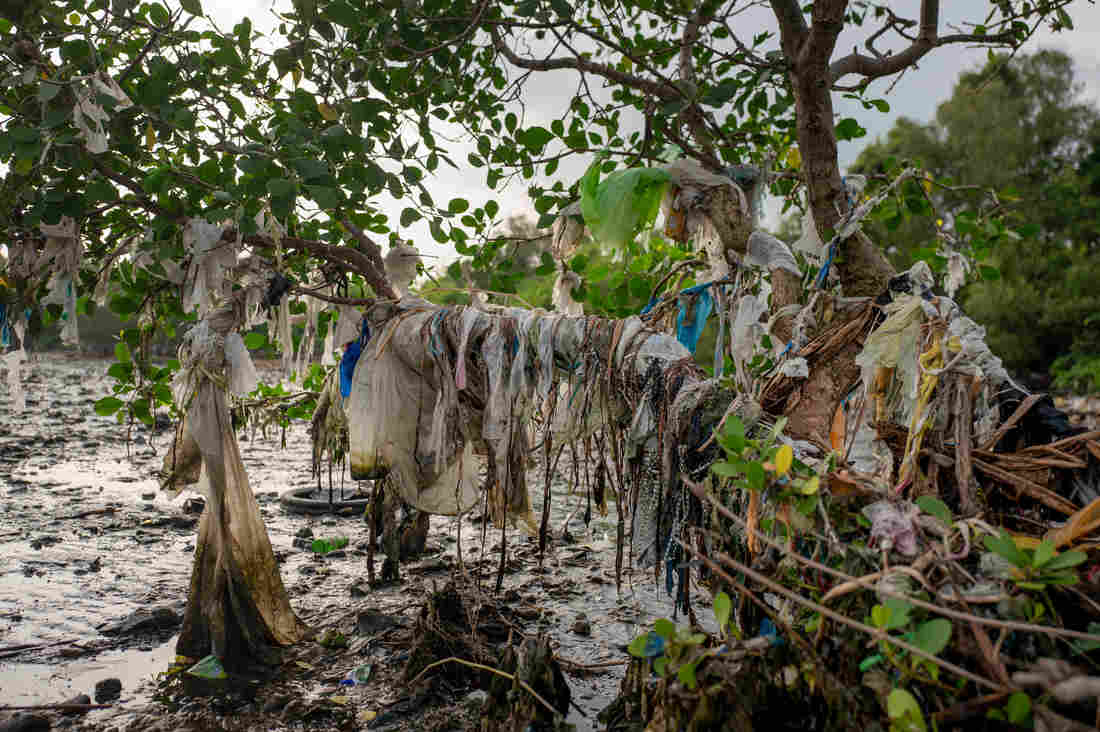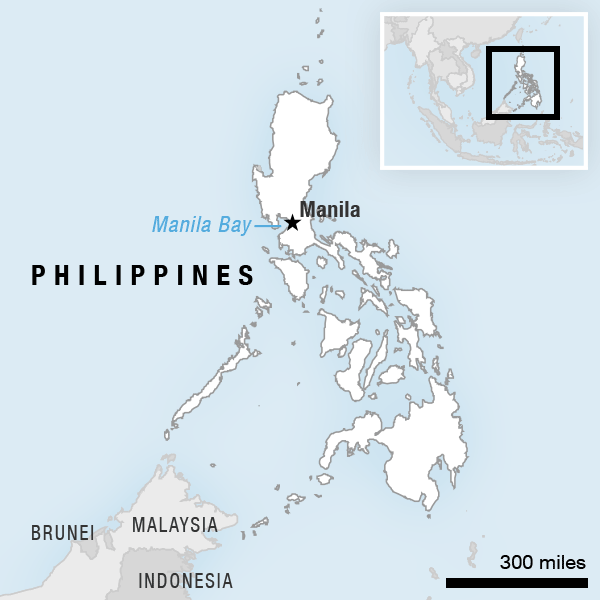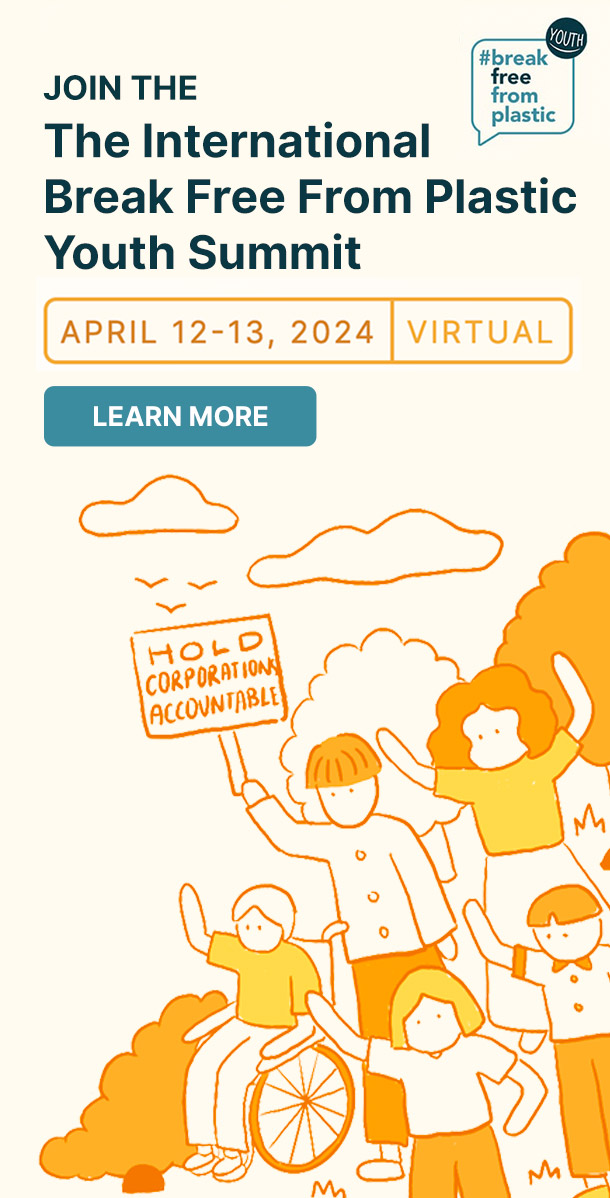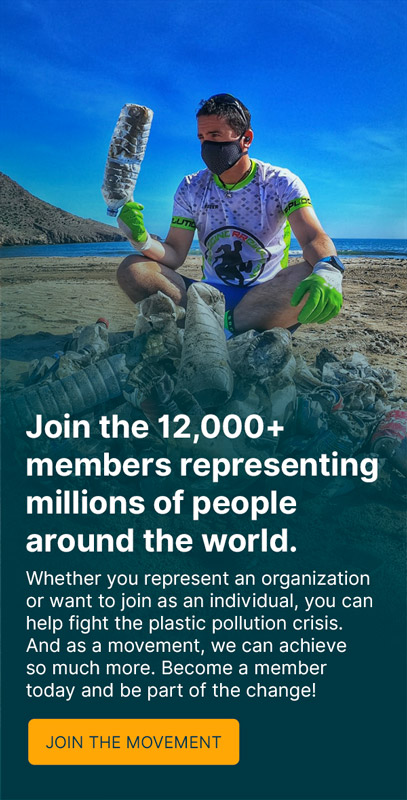Try this: Write a list of every piece of plastic you touch in a day.
I did it. I stopped counting at 56 items.
Plastic is to our time what wood was for millennia. But unlike wood, most plastic doesn't go away. It ends up as trash in streets, rivers, lakes and oceans. It breaks down into microplastic — particles a tenth of an inch or smaller — and gets into our food and water. The health effects are largely unknown.
News stories feature dead whales and turtles with stomachs full of plastic. Activists built a huge floating net to collect it (which recently failed). Concerned citizens clean up beaches.
But that's not helping much. Eight million tons of plastic wash into oceans every year.
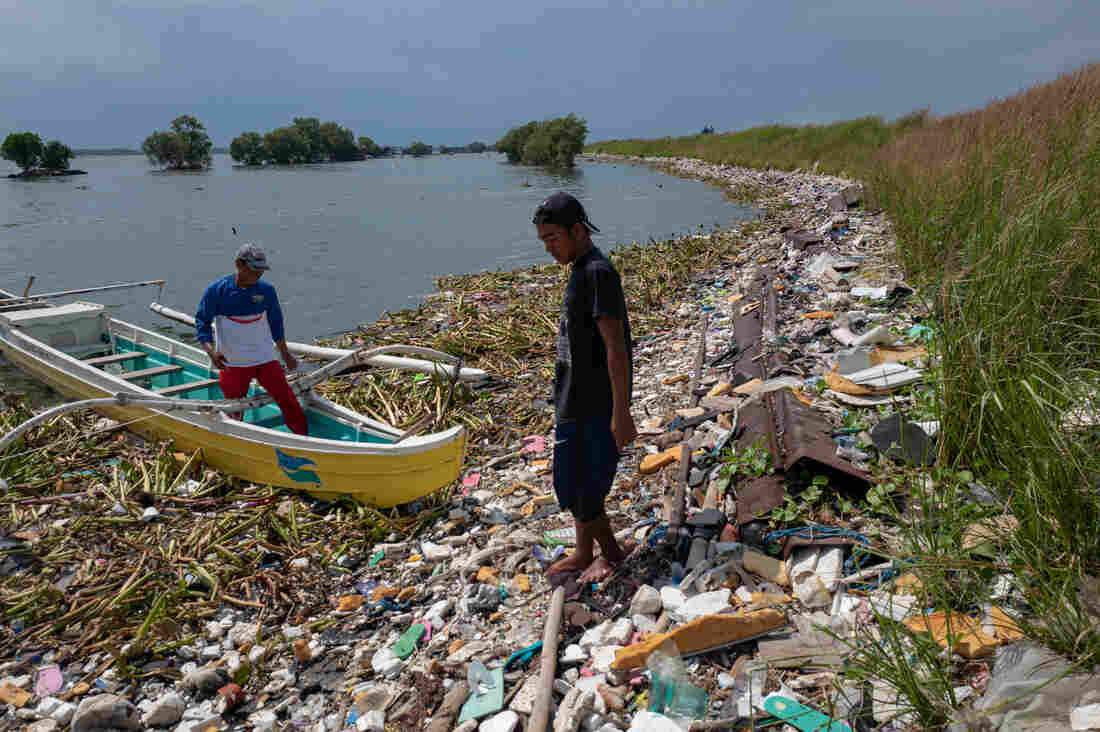
This line of garbage extends all the way around the shore of the Navotas neighborhood in Manila. Jez Aznar for NPR
What's the alternative? Is it feasible to persuade the wealthiest, most profitable corporations in the world to completely change the way they make plastic and package consumer goods?
There's a group of people in a very unlikely place who are aiming to do just that. Their story starts in 2001, in Southeast Asia.
"Island Boy" on a mission
Froilan Grate doesn't come across as a fire-breathing revolutionary. At 35 and just maybe 5 feet tall, with a wispy goatee, he has the kind of sincerity you might expect from someone who once wanted to be a priest. He carries a backpack and could pass for a college student.
He grew up in a village in the province of Iloilo in the Philippines — a self-described "island boy" who loved the feel of hot sand on his bare feet and swimming in the ocean. But the city beckoned. He was accepted by one of the country's best universities in the capital. He chose school instead of the priesthood. At age 18, he took a 19-hour boat trip to Manila.
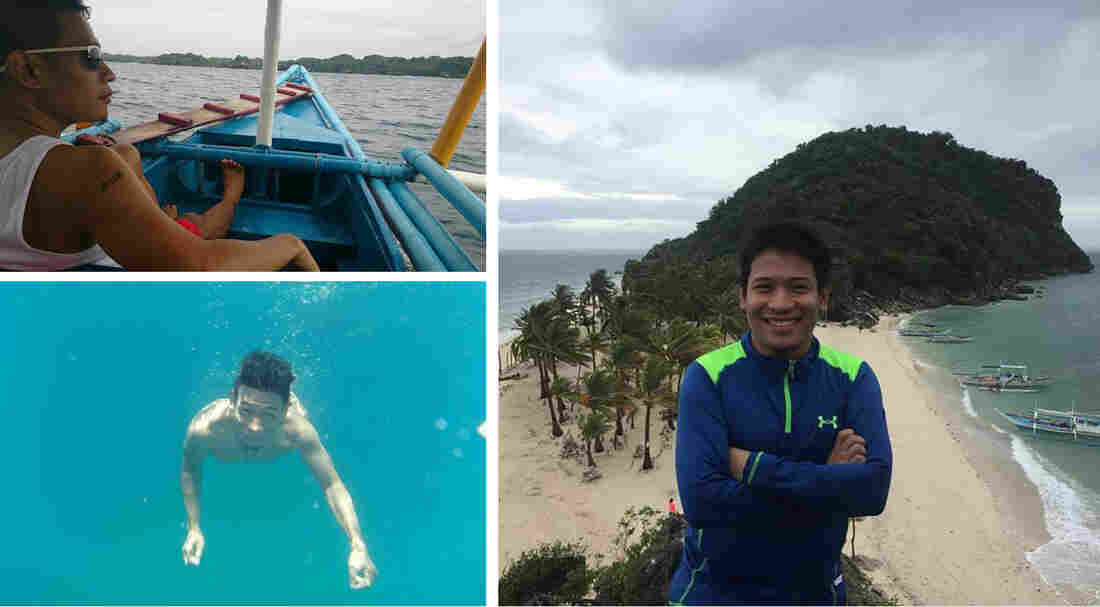
Froilan Grate at his home in the province of Iloilo. He came to Manila at 18 for college — and found his life's work: fighting the tide of plastic. Courtesy of Froilan Grate.
Grate remembers grabbing his suitcase and rushing up on deck as the captain announced their entry into Manila Bay. "It was just excitement," he says. "And then slowly, as you come closer to the port ... I see ... garbage."
He felt sick. "The contrast of where I grew up, beautiful white sand beaches, clear water, and arriving in Manila where it's black water with countless plastic," he says, "that was shocking to me."
His first thought at the time, he says, was that his own island would someday end up strewn with plastic as well. His next one was: What can I do to stop it?
The trash that trash pickers won't pick
Now, Manila Bay is much worse. With a growing economy and a swelling middle class, people are consuming at a torrid pace — electronic devices, packaged foods, fancy toiletries — goods either made of plastic or wrapped in it. In fact, that's the story of many Southeast Asian countries.
But waste management is rudimentary and often nonexistent. In many places, informal cadres of waste pickers collect what they can sell to recyclers. But much of the plastic cannot be recycled. So no one collects it, and it drifts. Everywhere.
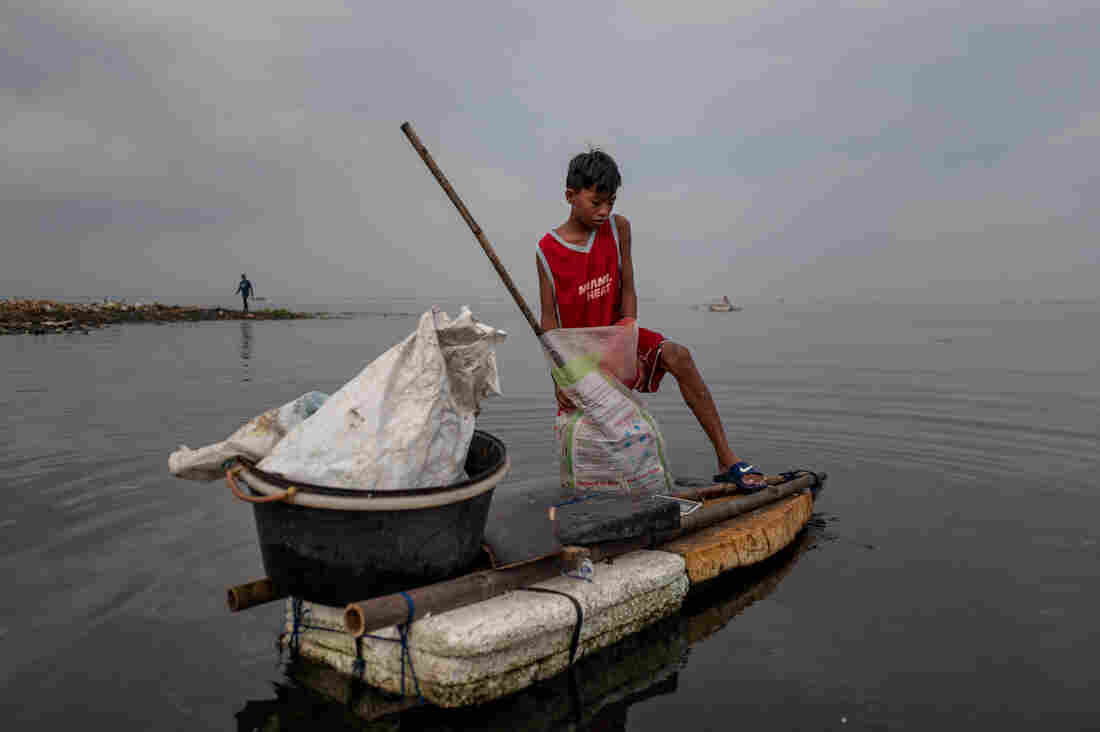
Children fill sacks with plastic trash from Manila Bay that they intend to sell to recyclers. Jes Aznar for NPR
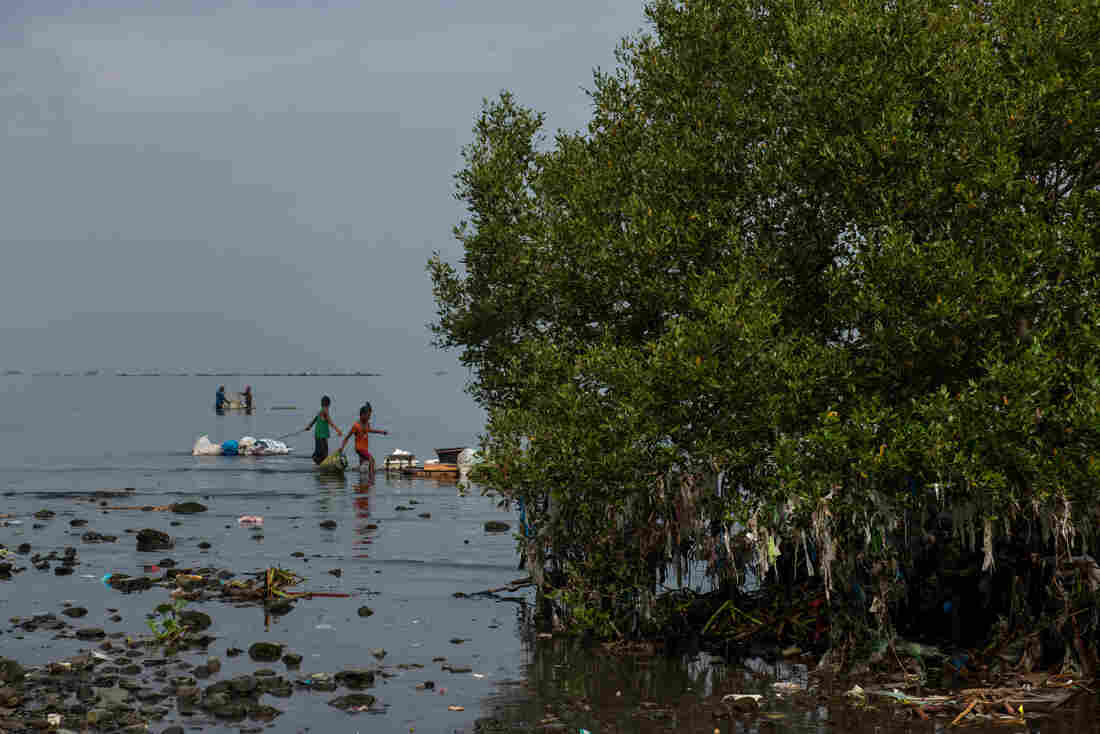
The islands that dot Manila Bay are like doormats for plastic trash that floats in from the ocean. Jes Aznar for NPR.
Neighborhoods like Dampalit, which lie along the bay, are like doormats for floating plastic trash. I talked to Dampalit's newly elected supervisor, Carlo Dumalaog. He is a neatly dressed businessman in a neatly kept office.
"My characteristic is, I am an obsessive-compulsive person," he says. He takes me out to the balcony of his office, where he can steal a smoke and look out on the nets of the village fishponds and the corrugated rooftops of shanties built along the water. "That is the Pacific Ocean," he says, pointing to Manila Bay and beyond. "All the trash from Manila Bay washes here," he sighs. "I clean the trash and plastics, but it comes over from the other cities." And, he says, it also comes from the Pacific, from other countries.
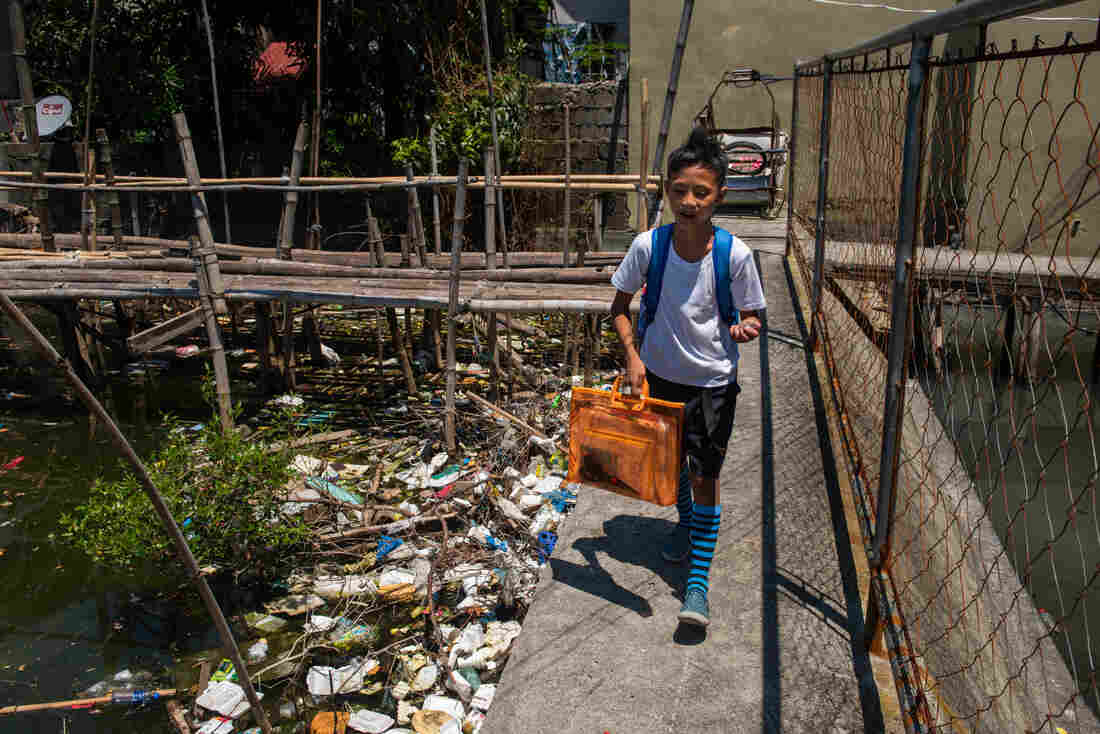
Dampalit, a fishing community in Manila Bay, has to contend with a constant influx of trash that it can't keep up with. Jes Aznar for NPR.
Saying no to plastic
At university, Grate did what he could as a citizen. He stopped using plastic bags, plastic straws, plastic anything, whenever he could. He studied sociology but found it boring — too theoretical. After college, he decided to become a community activist.
He got involved in teaching about environmentalism, what he called "giving tools to change-makers." But he wanted faster change. "You don't actually save a marine turtle by speaking to 1,000 students at a time," he says. He joined an environmental group, the Mother Earth Foundation, and worked with waste pickers to get them formally employed by communities and to improve their working conditions.
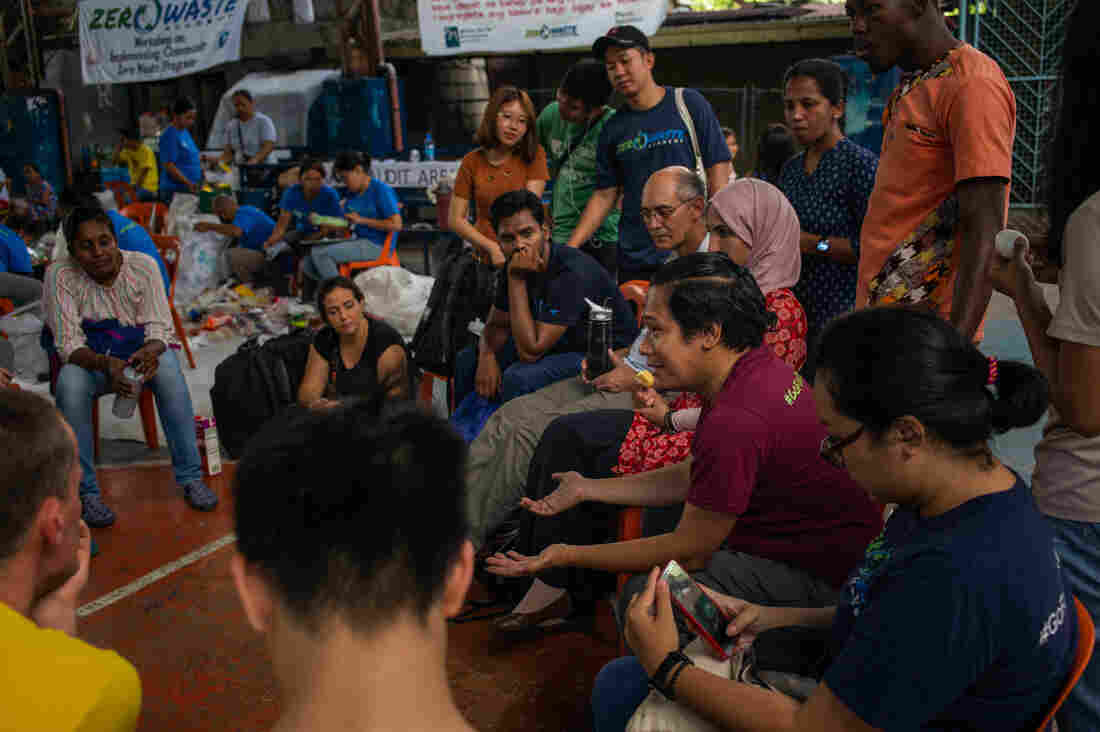
Froilan Grate publicizes the logos on plastic trash to encourage manufacturers to find alternatives. Above, he speaks to foreign visitors who face a similar dilemma. Jes Aznar for NPR.
But it still wasn't enough. "You realize that despite everything that you do, you really aren't solving the problem," he recalls.
With the foundation and backing from international environmental groups like GAIA, Grate helped teach communities to collect their own waste and segregate out the plastic. The goal was "zero waste" — impossible to fully achieve but an aspirational goal.
In the zero-waste neighborhood of Hulong Duhat, waste workers were hired to roll carts through a warren of alleyways, collecting bags of trash. They have a monitor, too, who charges fines if residents don't separate out the plastic. Those were the rules. "First offense, 500 pesos," says Dahlia Sequita, a community trash monitor, with some relish. "Second offense, 1,000. And third — going to jail!"
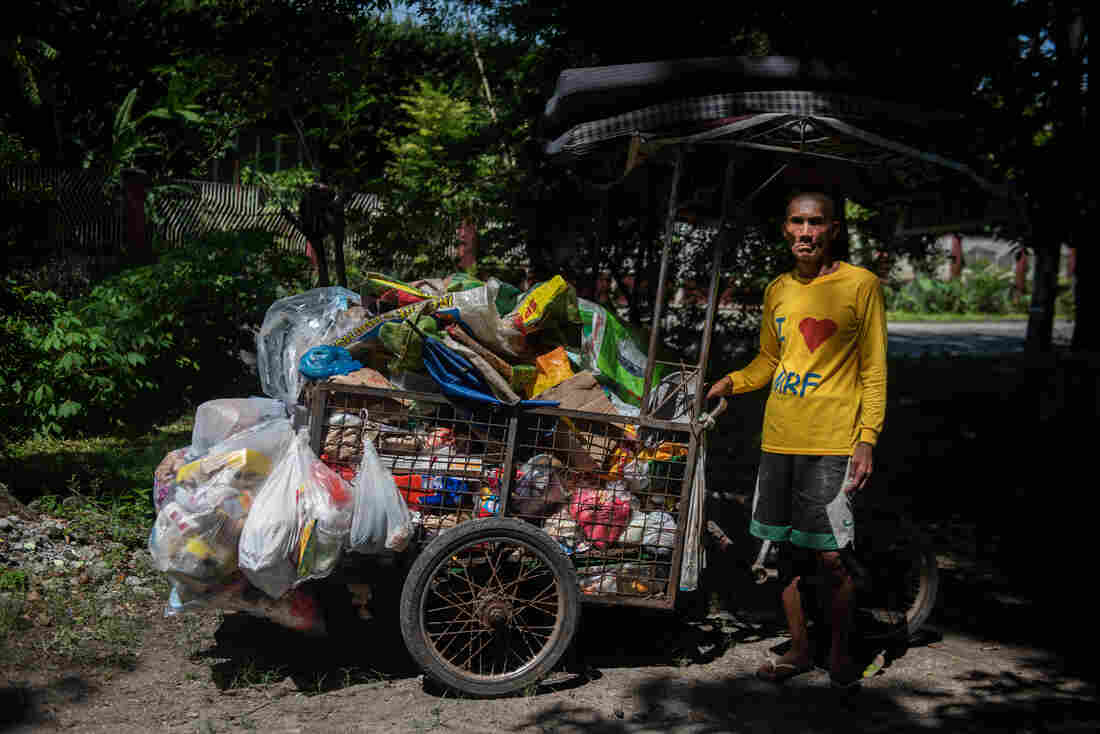
Alex Fruelda, 59, has been a garbage collector in San Fernando city, north of Manila, for nearly 10 years. Officials say the city recycles or composts 85 percent of its waste. Jes Aznar for NPR.
Even so, it's still hard. Says the neighborhood supervisor, Nenita Labiano: "Sometimes I do get overwhelmed with the big problem of plastic." Some people don't cooperate. "We want people to follow the rules," she says, "and yet they don't and it can be sad."
Sixteen neighborhoods signed on to the zero-waste goal nonetheless, with varying degrees of success. The same problem besets them all — it's not just too much plastic but it's the stuff that can't be recycled. There's nowhere to put it, except in landfills, which are few, and from which plastic eventually migrates, by wind or water.
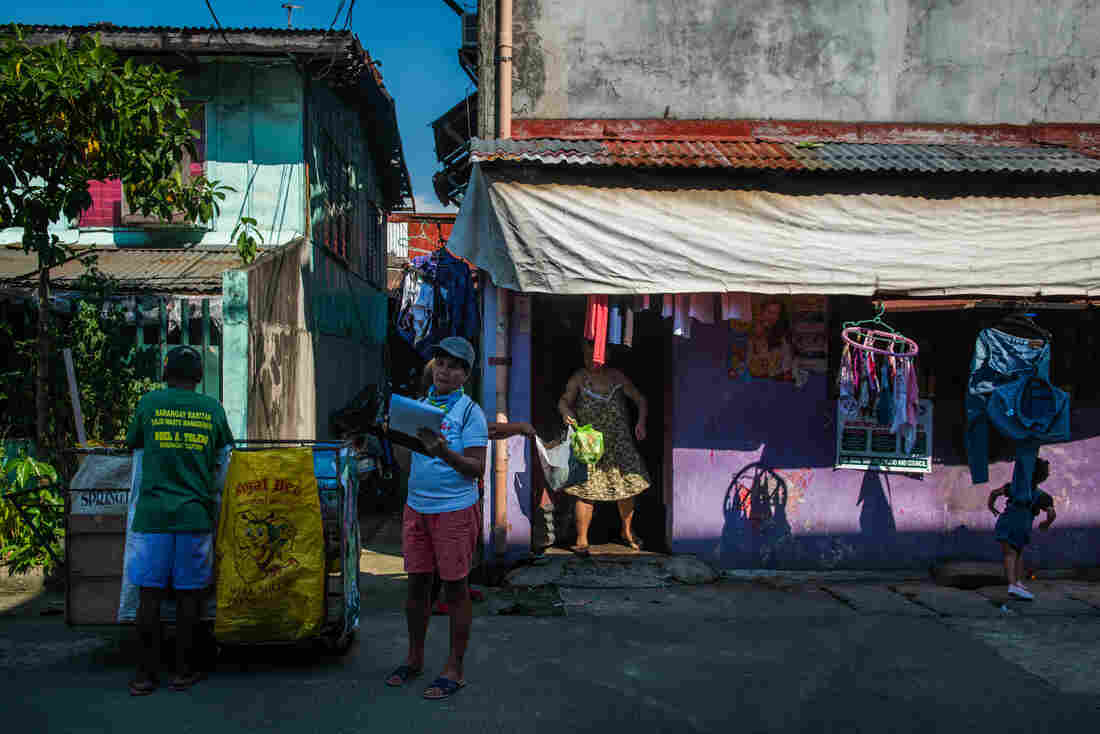
The Baritan neighborhood in Malabon city has adopted a "zero waste" policy that requires citizens to sort their trash and separate out the plastic. Above, trash collectors at work. Jes Aznar for NPR.
The life span of plastic
In the late 1940s, plastic was newly popular and shiny and amazing. Consumer goods companies advertised its cleanliness and durability. What they didn't talk about much was its permanence.
At the first national conference on packaging waste held in California in 1969, some executives wondered where all this plastic was going to end up. One marketing consultant said that wasn't their problem. Difficulties with plastic waste "are not the responsibility of those who produce materials, fabricate packages and package goods," he wrote in "Proceedings: First National Conference on Packaging Waste." Rather, he said, it's the consumer's responsibility.
What manufacturers did was urge people not to litter, as they had for years, by funding the "Keep America Beautiful" campaign. And they continued pumping out new kinds of plastic with yet more uses.
A profusion of packets
In the Philippines and other parts of Southeast Asia, the problem was compounded by a new kind of plastic packaging that took flight in the 1980s — the sachet. It was a plastic pouch but often bulked up with layers of aluminum or paper for shape or durability. Think of ketchup packets at a fast-food restaurant.
Sachets are cheap, flashy and convenient. An Indian company used them to sell shampoo or soap or snacks to the poor, who might not have enough cash for a larger purchase.
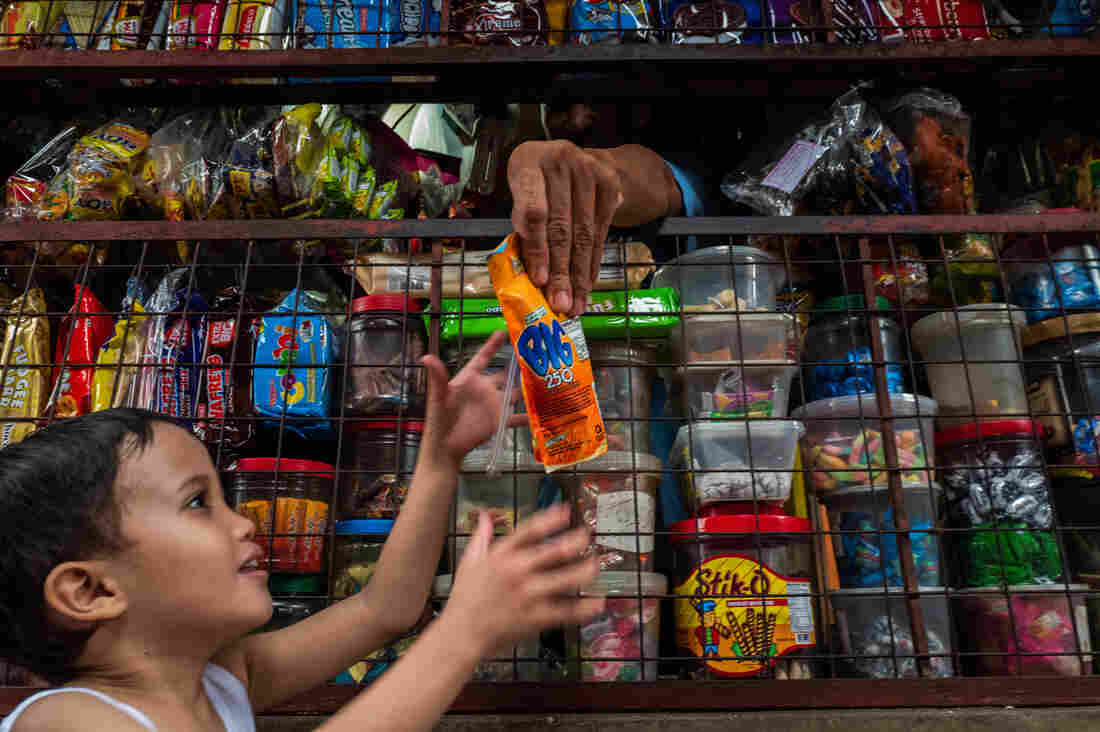
There are millions of sari-sari stores throughout the Philippines. Sachets, which are not recyclable, are a big part of their stock in trade. Jes Aznar for NPR.
Other big companies followed suit with the same marketing strategy: a product the poor could afford, a day's supply of what they needed.
Eventually, sachets went viral.
The big drawback, though, is that they cannot be recycled easily. That may not be such a problem in wealthy countries with efficient waste management. But in poor parts of Asia, the packets have created an epidemic of trash.
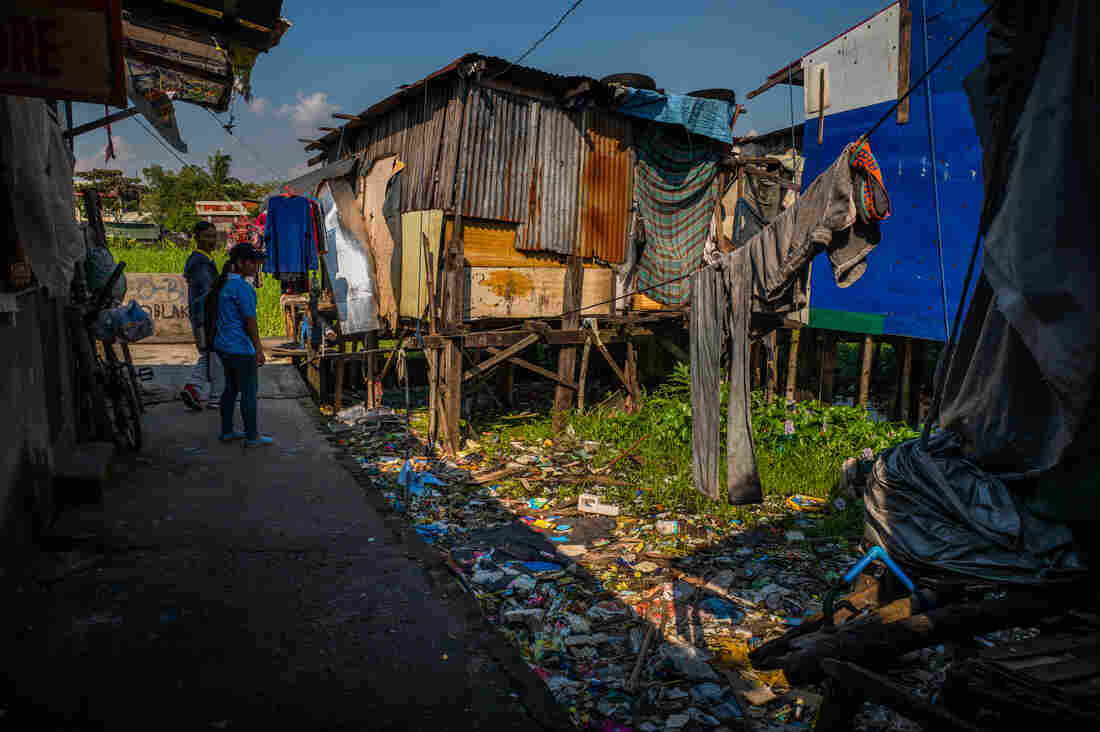
Because the plastic sachets that hold food and other consumer goods can't be recycled, independent waste pickers don't collect them and they end up everywhere. Jes Aznar for NPR.
You can't drive into Maysilo, a poor neighborhood in Manila near the edge of Manila Bay. You have to walk through narrow alleys. The place greets you with a burst of boombox music, the shouts of children, and barking dogs. People live elbow to elbow in shacks elevated a few feet above ankle-deep water from the neighboring swamp. Below their shacks, you can't tell whether it's dirt or water because it's all literally covered with a uniform carpet of plastic debris, most of it empty sachets.
Nimfa Manlabe runs a sari-sari store (sari means "varied" in Tagalog) out of her tiny home. It's a Filipino tradition; women selling consumer goods from their homes. "Sunsilk, Palmolive, conditioner," she says, showing off her racks of sachets.
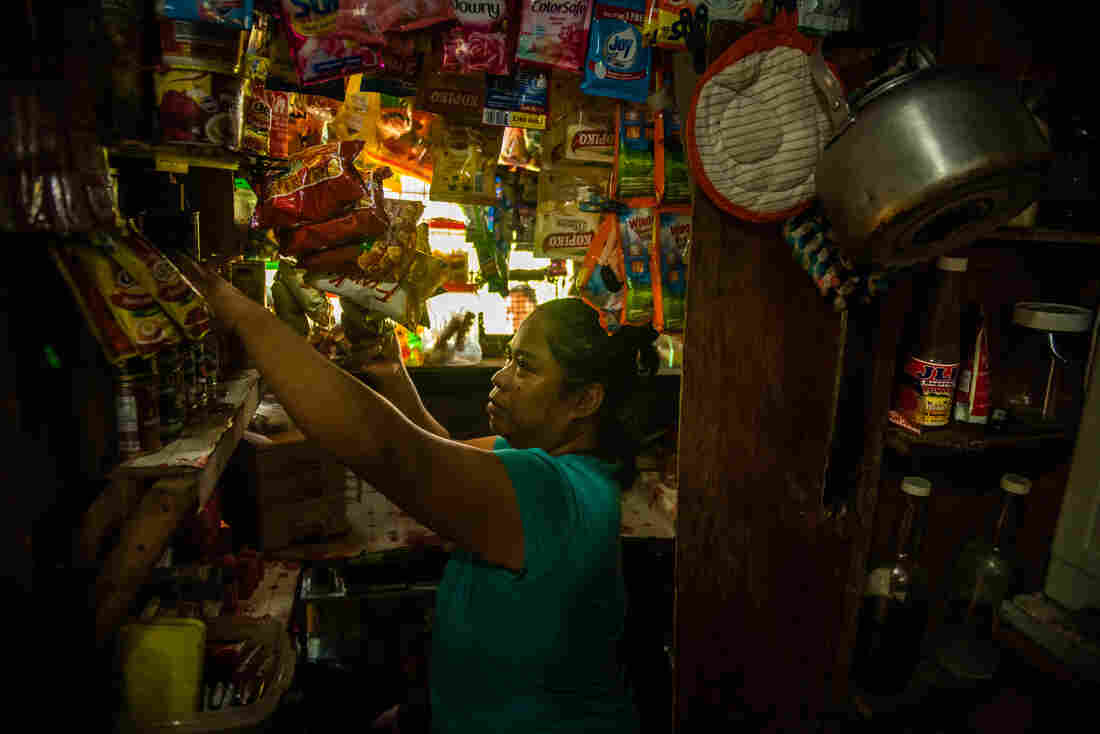
Nimfa Manlabe, 46, boosts her income by selling consumer goods in sachets from her sari-sari store in her home in Manila. This is a common way for Filipinos to get their daily supplies. Jes Aznar for NPR.
Her customers "come back here every day and buy these small amounts because that's what they can afford," she explains.
Because the sachets aren't recyclable, trash pickers ignore them. And even if the packets were recyclable, Grate says, most places in the Philippines don't have the infrastructure to actually recycle them.
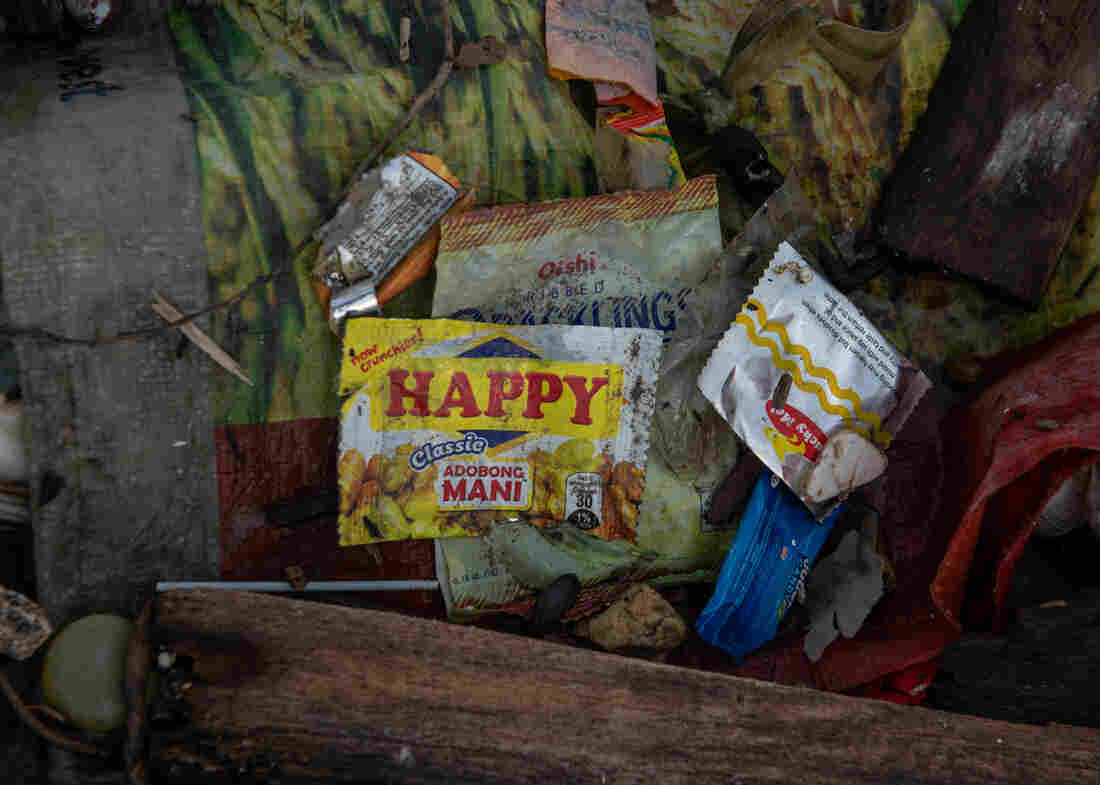
Sachets like these, developed to market consumer goods to the poor, have become ubiquitous all over Asia. Jes Aznar for NPR.
But sachets and other plastic packaging do have their supporters — like Crispian Lao, who used to be in the plastics industry and is now head of the Philippine Alliance for Recycling and Materials Sustainability. The group represents recyclers as well as companies like Unilever, Coca-Cola, Nestlé and others that make and package consumer goods.
Lao praises the sachets for bringing quality products to consumers in a market where counterfeit goods are common. "There's also the health issue," he says: Sachets don't pose health risks to the consumers in places where water to wash reusable containers might be contaminated.
Lao notes that the world's biggest consumer goods companies like Unilever and Nestlé have pledged to make all their packaging recyclable and have even set a date — 2025.
But Grate says that recycling can't wipe out the barrage of plastic in the Philippines. It's a country of more than 7,000 islands. Neither the national government nor local authorities can afford to put up recycling centers everywhere. And would recyclers pay enough to motivate waste pickers to collect the trash?
Grate says talk of future recycling still puts the burden of cleanup on the consumer. "The problem," Grate says, "is that most companies ... feel their responsibility ends the moment they sell it. That's one of the biggest injustices here."
A lesson from a letter
After several years of community work, Grate says he changed. He realized that cleaning up plastic at the local level wasn't going to stop the tide. "It would take several lifetimes," he recalls thinking. "At some point you have to change the entire system."
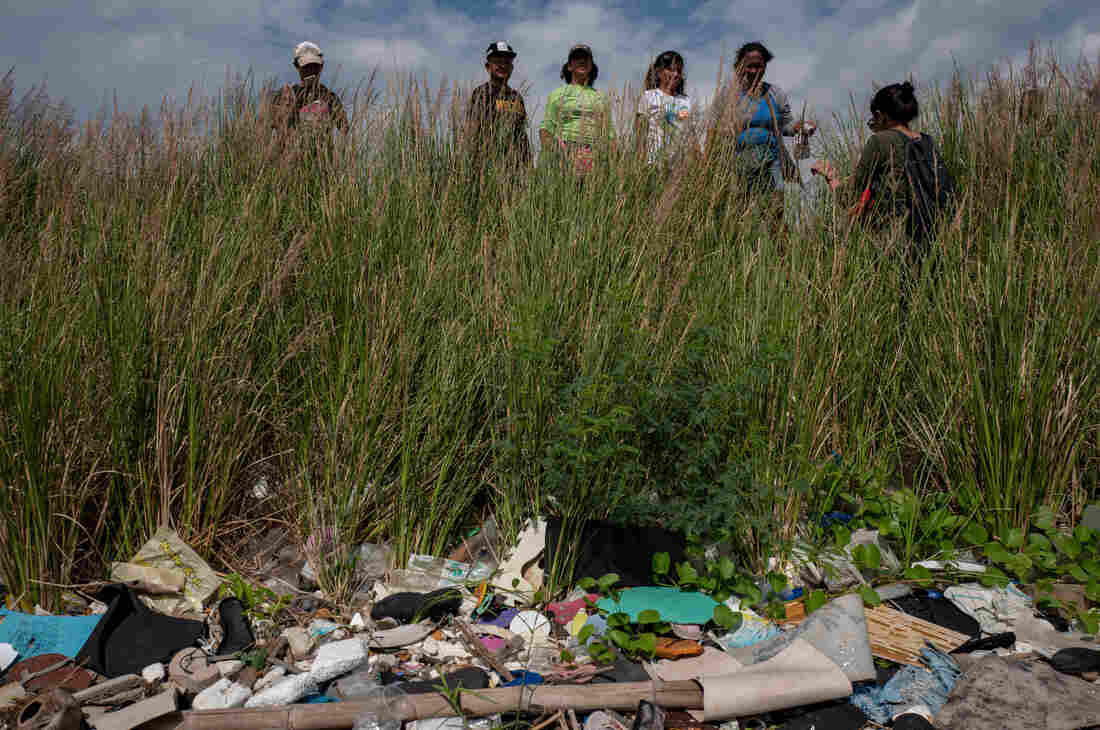
The citizens of the neighborhood of Navotas participated in a brand audit, where household trash was collected and the brands were listed and publicized. Jes Aznar for NPR.
One incident stands out in his memory. In 2006, he appealed to a big Western company for help. He and his colleagues at the Mother Earth Foundation and Greenpeace wrote to McDonald's to urge it not to use plastic foam packaging. He took the letter to the corporate offices in Manila. No one would come down to talk to him. Eventually a security guard agreed to take the letter.
"That very moment really crystallized for me the imbalance in the power dynamics," Grate says now. " We were not violent. We just wanted to give a letter requesting them to stop using Styrofoam in their stores." And they simply ignored him.
Blaming Southeast Asia
In 2015, a paper in Science magazine shocked the world with extraordinary revelations about the extent of the plastic tide. Jenna Jambeck at the University of Georgia, an engineer and waste expert, calculated how much plastic waste was going into the ocean every year. She is the one who came up with the 8 million-ton figure.
The research also opened up a wound. It showed that the biggest sources of plastic waste washing into the oceans are in Southeast and South Asia.
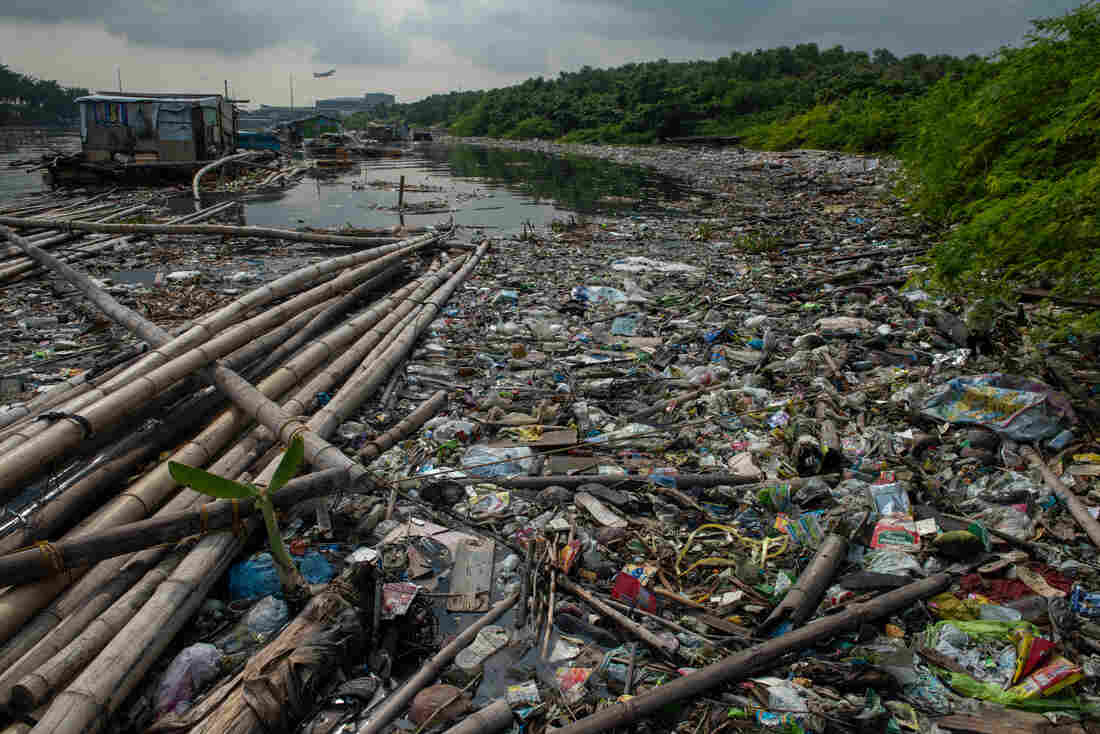
Freedom Island is typical of so many islands in Southeast Asia that become magnets for floating trash. Jes Aznar for NPR.
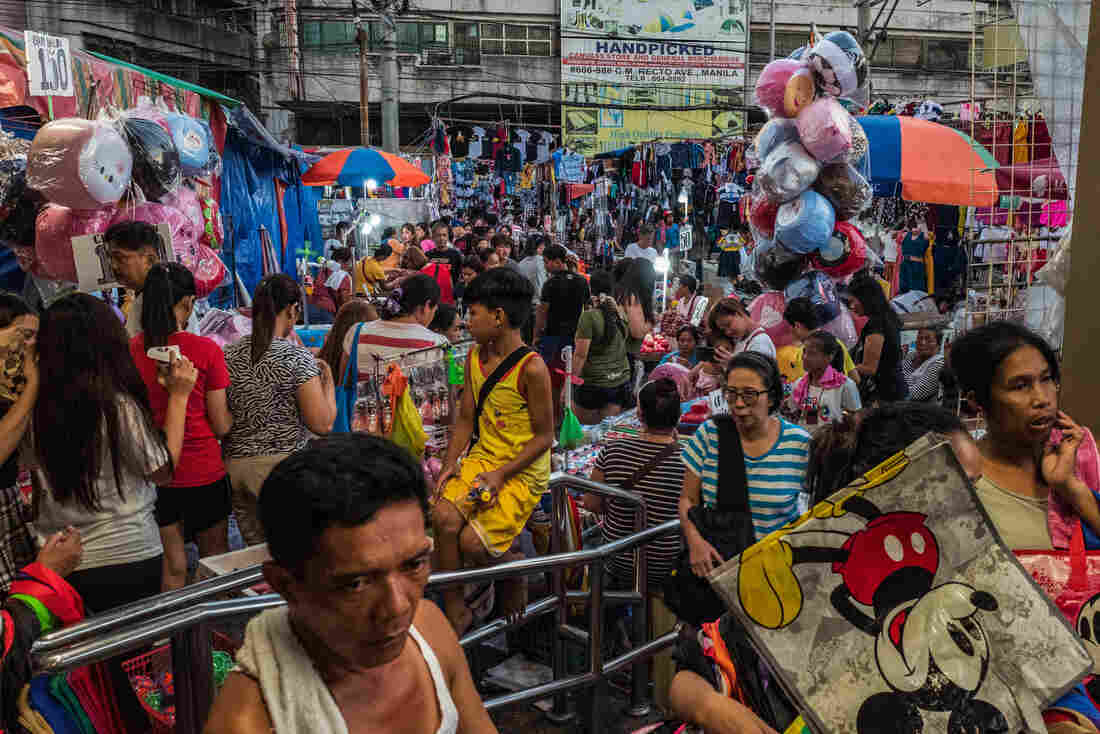
Manila vies for the title of most densely populated city in the world. At the city's crowded markets, like the one above, increasing income has boosted the sales of consumer goods packaged in plastic. Jes Aznar for NPR.
Fingers were pointed. Sen. Sheldon Whitehouse, D-R.I., laid it out loud and clear in a Senate hearing: "Over 50 percent of the plastic waste in the oceans comes from just five countries: China, Indonesia, the Philippines, Vietnam and Sri Lanka. Their upland waste management systems are a failure."
People in the Philippines were angry — among them, Grate. It was blaming the victim, not the manufacturers. "They know the problem, the s*** they've been giving to the country and oceans," he says. "They know this problem, but they can get away with it. We have to make sure that ends."
A group called Break Free from Plastic came together in 2016. Its global coordinator is a Filipino, Von Hernandez, formerly of Greenpeace. The plan was to challenge companies. Says Hernandez: "If we cannot recycle it or compost this material, then you should not be producing them in the first place."
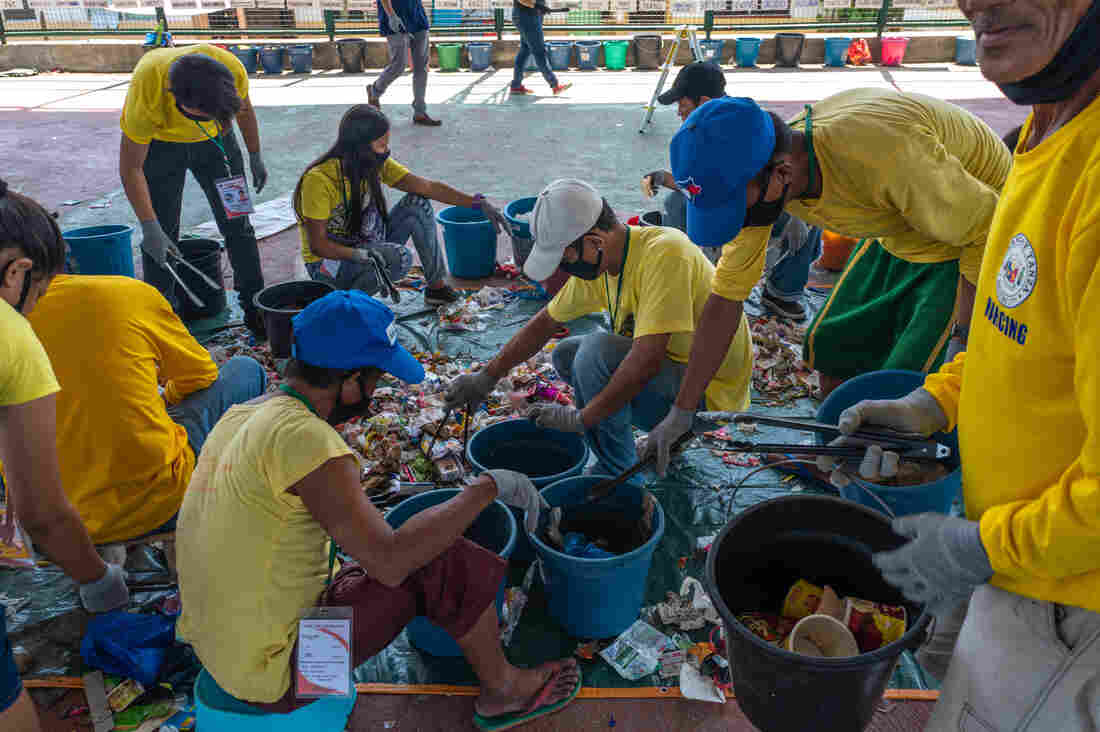
Volunteers sort trash items in a brand audit of plastic waste in Navotas, Manila. They keep track of the brands they find and publish results on the Web. Their goal is to pressure companies to change their plastic packaging. Jes Aznar for NPR.
But how to make that happen? The consumer brands were billion-dollar companies. And the companies that make the plastic for all that packaging were giants of the oil and gas industry.
As for the pledge for 2025, no one knows how companies will do it and how much it will cost to set up a huge recycling system across the islands of the Philippines.
In 2016, Grate and other local activists in the Philippines proposed a novel action, something no one had done before: brand audits.
These environmental groups did regular beach cleanups, which helped bring attention to the problem even if the beaches were covered with trash again a few months later. But now they wanted to compile a list of the brand logos emblazoned on the plastic trash and publicize them for all to see.
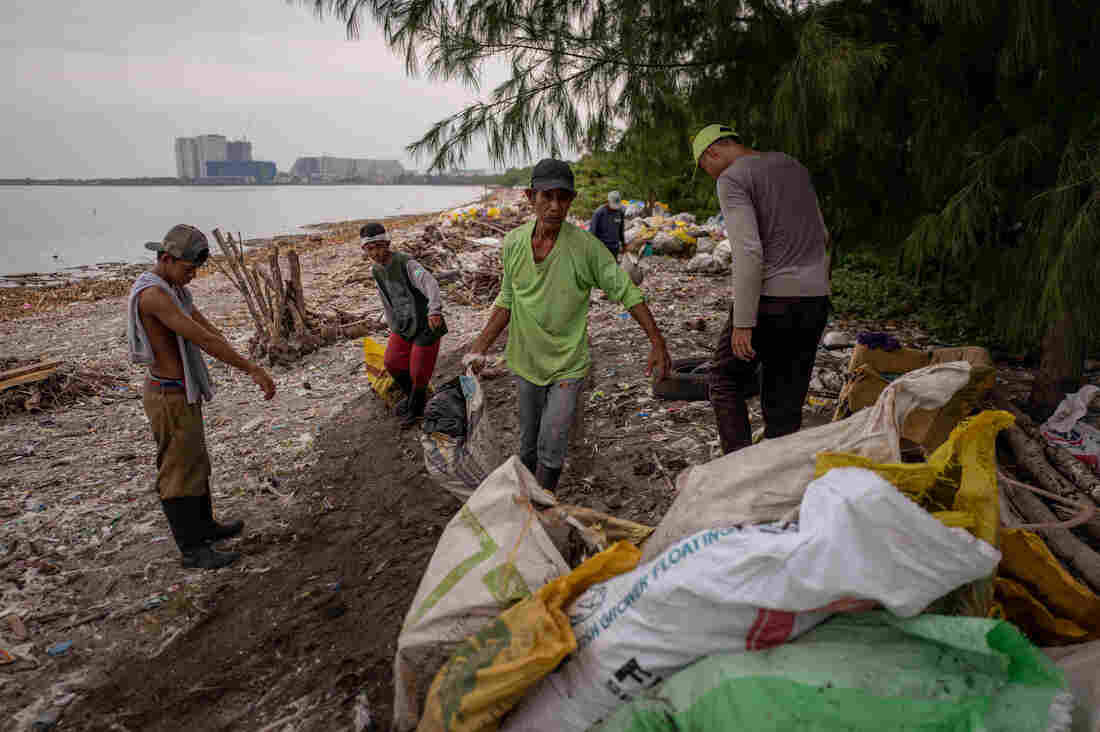
Workers collect and sort garbage on Freedom Island. Jes Aznar for NPR.
"They feel there is value in brand," Grate says of the companies. Consumers trust brands. "We wanted to use it against them."
The activists targeted Freedom Island in Manila Bay, probably the most notorious pit of plastic in the country, for a brand audit. Plastic not only surrounds the shore but piles up knee-deep on beaches. Plastic bags hang from trees like some kind of surreal Dalí painting. The activists collected trash for days and published online the brand logos printed on each package.
And they waited to see what would happen.
Is anyone watching?
Not much did, actually. Word spread among conservation groups that this "brand audit" was a new strategy. It was naming and shaming. But was anyone else paying attention?
Grate and his team didn't know, but they kept at it. Along with GAIA and Break Free from Plastic, they've now done more than 20 brand audits in the Philippines and several in other Southeast Asian countries.
Last September, I saw one in a village called Navotas, a poor neighborhood of cinder block dormitory-style buildings on Manila Bay that floods twice a day, carrying plastic back and forth like some sort of oceanic seesaw. For the audit, volunteers sift through piles of trash, in this case collected from homes. The idea is to see not just what floats onto shorelines but what's coming from onshore.
It's dirty work — eight days of community trash spread in piles on the concrete floor of a fenced-in outdoor basketball court. It stinks; workers wear masks and gloves.
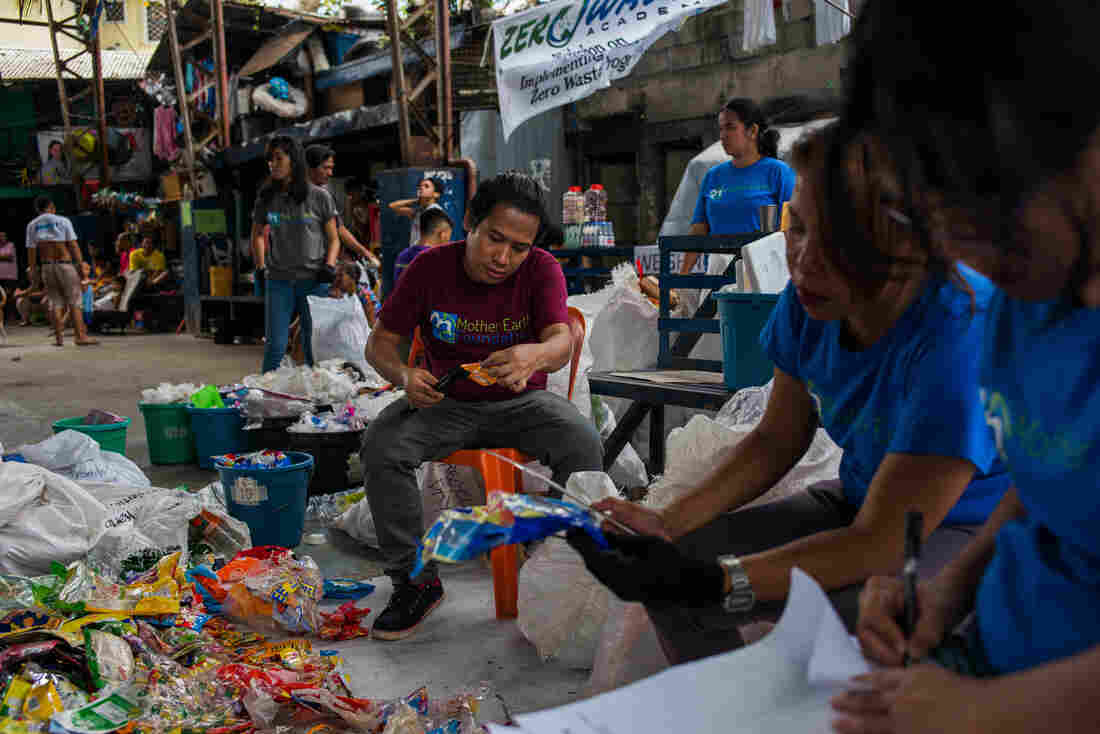
Froilan Grate calls out the brand names of plastic trash in a waste audit. Jes Aznar for NPR.
Grate dives in, sorting trash into different types of plastic and reading off labels while a colleague takes notes. "Colgate toothpaste sachet," he says. "Colgate-Palmolive Philippines." And another: "Sunsilk shampoo sachet, Unilever." It will take all day to go through all of it.
He says the companies should be part of the solution. "So who are the companies?" he asks. "That is why we do brand audits."
Lao, with the Philippine industry group, says the brand audits are a distraction. "There's a lot of very loud noises out there" about corporate responsibility, he points out. "Does it affect brand image at this point? No," he says of the audits, adding, "It has not affected actual performance of these brands in the market."
He says the major consumer brands are already committed to reducing plastic waste. He notes the well-publicized pledge by the brands that by 2025 they'll use only plastic packaging that can be reused, recycled or composted. In fact, Unilever has a new chemical process to recycle sachets and a pilot plant in Indonesia to test it. Other companies have committed millions of dollars in research funds to find recyclable alternatives.
In the Philippines, Lao's industry group is planning a research and development effort there to make more plastic recyclable. "The idea right now is that how can we now together, with the global partners, redesign the product so it becomes more recyclable, [and] look at recycling the existing products that are there?" he asks, "because [they're] not going to disappear overnight."
Activists are skeptical.
A surprise invitation
But Grate's name-and-shame approach appears to have had some effect. Late last year, he got a call out of the blue. A mediation group, the Meridian Institute in Washington, D.C., invited him to come talk to people in the U.S. who were concerned about plastic waste. It was a surprise to him. He didn't know how far news of his audits had traveled. And even more surprising: The people in Washington wanted him to talk with corporate executives from some of the very companies he had been targeting.
I met Grate in Washington, D.C., on a cold sidewalk in December. "I love this weather," he said. "It's like free air conditioning." He said he felt he had to come to the meeting because there was only one other Asian invited. When he got there, he found himself sitting across from senior executives from the oil industry, the chemicals industry and the consumer goods industry. Not just any companies — some of the world's biggest. He was asked not to name them; one attendee told NPR that anonymity was guaranteed so everyone could speak freely.
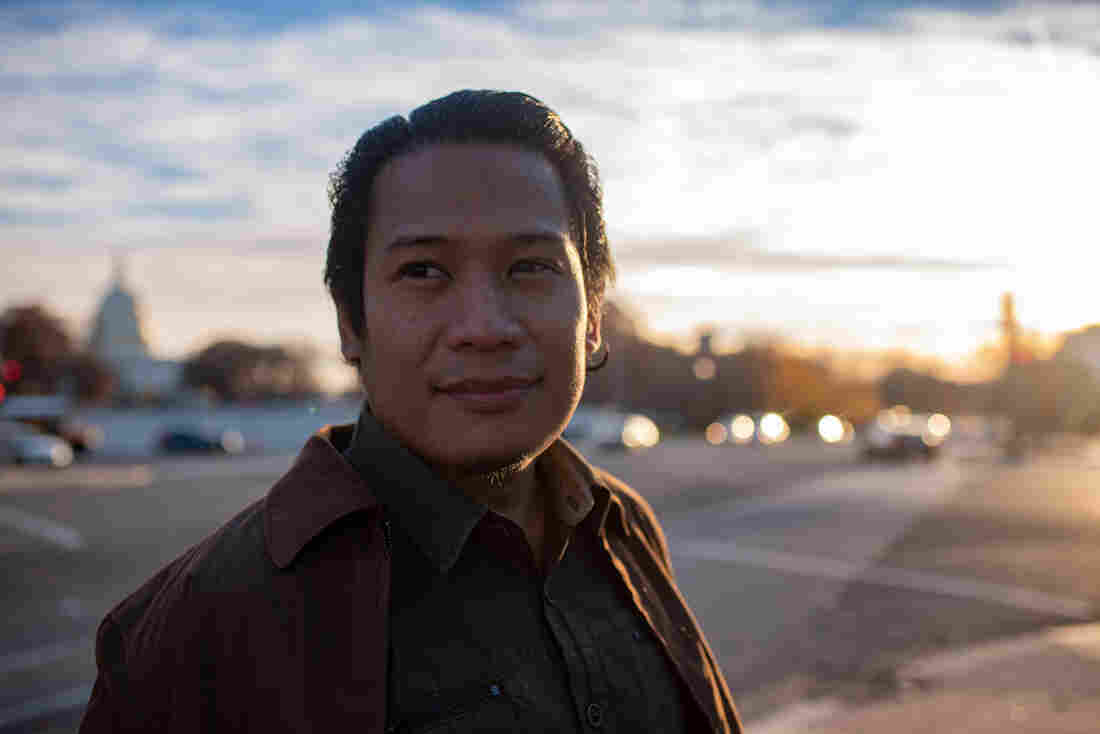
Froilan Grate in Washington, D.C., in December. He was invited to meet with industry representatives about the plastic tsunami in Asia. Madeleine Cook/NPR
I asked Grate if the brand audits made the meeting happen? "They weren't happy about it," he said of the audits. "And they have questions," he added, about how his group does them. "But I would say this: The brand audits contributed to the pace of the discussion that's happening right now."
I asked how he felt about that. "It's great," he said, beaming. "I was made to feel that I have a voice, and people would want to listen to what I have to say. People were actually interested."
After 18 years, says the island boy from Iloilo, things are looking up.
NPR's radio stories on plastic in the Philippines were produced by Rebecca Davis and edited by Geoff Brumfiel. Wilma Consul helped with translation and voiceovers.
Originally posted in NPR.

